We know that in any repair process, better processes upstream can reduce costly problems. One of those processes is correct estimating. In 2001, a number of us in the U.K. repair industry recognized that correct estimating was absolutely essential in order to deliver the correct results for a successful business.
If you happened to read my comments in last month’s FenderBender, you are probably aware that this coincided with the development of standards to create an accredited body shop that insurance carriers would recognize and send work to. Estimating became an integral part of our new PAS125 standard. Within the standard it is a requirement for estimators to take a two-part examination in both theory and practical terms to achieve what we call Vehicle Damage Assessor Automotive Technician Accreditation (VDA ATA). This exam must be carried out every three years. The failure rate when we started this examination was in excess of 80 percent, so it’s a very difficult discipline to achieve and carry out successfully. It’s worth remembering that it’s your estimator that determines your business turnover.
An estimate, in simple terms, exists to achieve three things: the correct and safe method of repair, the correct parts requirement, and from that, the cost of the repair. The cost is a consequence of getting the first two correct. The challenge, of course, is to be able to initially understand the method of repair. What I mean by the method is it’s about understanding the construction of the vehicle in the first place, the materials used and the reconstruction methods recommended by the vehicle manufacturer. Without this information, it is impossible to construct an accurate estimate for a safe repair.
We in the U.K. market are lucky to have an organization called the Motor Insurance Research and Repair Centre (MIRRC) within an organization called Thatcham. Thatcham has a facility that tears new vehicles down completely, analyses their construction and determines the best method of repair and the associated time in order to complete each repair stage. This is then documented and made available via software called Escribe for an annual fee of about $2,000. About 50 vehicles and their derivatives are added each year.
This gives estimators, prior to writing anything down, a full understanding of the construction of the vehicle, issues around any active and passive safety systems and how its materials are welded, bonded or riveted together. It determines whether a vehicle can be pulled on a jig, or moved after a bonding process has been applied. It also deals with disconnection of high-voltage hybrid technologies and issues around ECU resetting. The correct tooling and welding equipment is also specified.
The VDA ATA process instills a very formalized method of assessing the vehicle. It ensures that the estimator talks to the car driver so that they understand the circumstances of the collision. They need to know the number of occupants and any other circumstances that may affect the structural integrity of the vehicle.
Estimators are taught to replace steering racks if there is any significant damage to wheels or suspension components, and to understand how the car will behave should it have a subsequent accident after it is repaired. If there is doubt about the parts or methods requirement, then the vehicle must go through a pre-strip or partial tear-down in order to identify in one single process both the method and parts required to repair the vehicle correctly, according to the manufacturer’s specification.
An estimate takes well in excess of an hour to complete, and we do not normally expect to complete more than 5–6 in one day from a single qualified estimator. Accurate estimating nearly always guarantees that there will be no supplementary estimates, no additionally claimed time or parts, and that the technician can be briefed accurately about the work to be carried out, so that the key-to-key time can be dramatically reduced while keeping profits high.
Here’s the best bit—insurance carrier assessors also have to complete the same examination as body shop estimators, which puts all parties on a level playing field. This significantly helps with the understanding between both parties, as the discussion stems from the method of repair rather than the price. This reduces the argument between insurers and shops, as there’s no bartering over price.
If accurate and detailed manufacturer repair methods are made available in the U.S., a methods-based approach to estimating might work just as well.
Jon Parker is managing director of the Byteback Group, a U.K.-based information technology and services company aimed at advancing the collision repair industry. Parker can be reached at [email protected].



